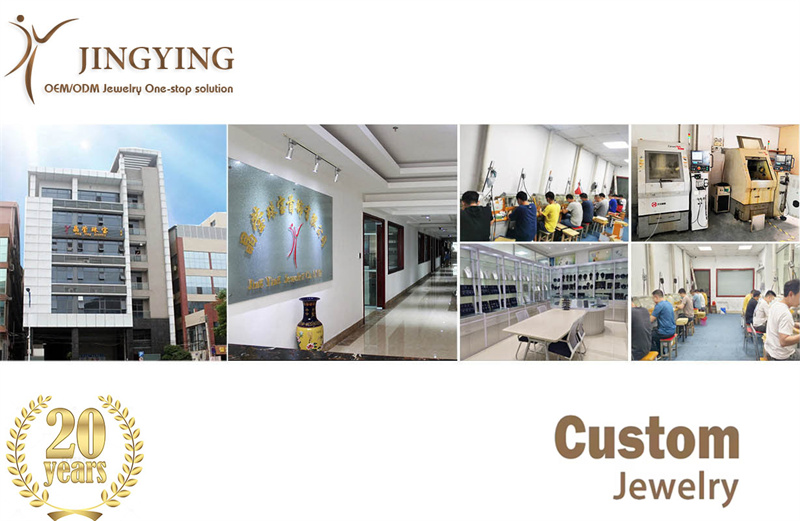金メッキジュエリーの卑金属: 真鍮対. 銅対. ステンレス鋼の説明
導入: 手頃な価格の高級品の基礎
金メッキのジュエリーは、ファッション ジュエリー市場の中で最もアクセスしやすいセグメントの 1 つです。, わずかなコストでゴールドの豪華な外観を提供. しかし, 金の表面の下にあるもの、つまり地金は、ジュエリーの耐久性を決定する上で重要な役割を果たします。, 外観, 摩耗性, そして全体的な価値. この包括的な 5000 語のガイドでは、金メッキのジュエリーに使用される 3 つの主要な卑金属について説明しています。: 真鍮, 銅, とステンレス鋼, ジュエリーメーカーへの提供, 小売業者, 情報に基づいた意思決定を行うために必要な知識を備えた消費者.
世界の金メッキ宝飾品市場, 価値がある $28.5 億で 2023, これらの卑金属に大きく依存しています, それぞれに異なる利点と制限があります. それらの特性を理解する, 製造上の特徴, そして、美しさのバランスをとったジュエリー コレクションを成功させるためには、パフォーマンスが不可欠です。, 品質, と価格.
1. 金メッキの科学: プロセスを理解する
1.1 電気めっきの基礎
金メッキでは、電気化学プロセスを通じて卑金属基板上に金の薄層を堆積します。:
プロセスのステップ:
-
表面処理: クリーニング, 研磨, そして電気洗浄
-
アクティベーション: 酸化物を除去するための酸浸漬
-
ストライクレイヤー: 接着用初期薄めっき
-
ゴールドメッキ: 主なめっき層の適用
-
後処理: シーリング, 漆塗り, または追加の仕上げ
主要なパラメータ:
-
電流密度: 0.1-1.0 A/dm²(母材に応じて異なる)
-
浴槽の温度: 45-65°C
-
めっき時間: 30-120 一般的な厚さの場合は分
-
金の厚さ: 0.5-5.0 商業用ジュエリーのミクロン
1.2 品質基準と厚さの分類
| 分類 | 金の厚さ | 期待寿命 |
|---|---|---|
| ライトメッキ | 0.5-1.0 ミクロン | 6-18 数ヶ月 |
| 商業めっき | 1.0-2.5 ミクロン | 2-4 年 |
| 重メッキ | 2.5-5.0 ミクロン | 3-7 年 |
| Vermeil | 2.5+ スターリングシルバーのミクロン | 5-10+ 年 |
2. 真鍮: 業界標準
2.1 構成と特性
真鍮, 銅と亜鉛の合金, およそを表します 65% 金メッキのジュエリーに使用されるすべての卑金属の合計:
一般的な合金:
-
C260 (カートリッジ真鍮): 70% cu, 30% Zn – 最も一般的な
-
C220 (コマーシャルブロンズ): 90% cu, 10% Zn – 暖色系
-
C280 (マンツメタル): 60% cu, 40% Zn – より高い強度
物理的特性:
-
密度: 8.4-8.7 g/cm3
-
ビッカース硬さ: 60-150 HV
-
融点: 900-940°C
-
抗張力: 350-500 MPa
2.2 製造上の利点
鋳造と成形:
-
優れた流動性で微細な鋳造が可能
-
良好な機械加工性 (80% 快削性評価)
-
スタンプしやすい, フォージ, そして形を整える
-
成形時のスプリングバックを最小限に抑える
めっき性能:
-
優れた金の密着特性
-
均一なめっき厚さ分布
-
最小限の気孔率で均一なめっきを実現
-
メッキ前の耐食性が良好
2.3 制限事項と考慮事項
潜在的な問題:
-
脱亜鉛化: 腐食性環境において
-
応力亀裂: 特定の化学物質にさらされた場合
-
カラーブリード: 薄いメッキを通して銅の含有量が見える場合がある
-
アレルギーの心配: 敏感な人の亜鉛反応
3. 銅: 伝統的な選択
3.1 材質の特徴
純銅 (C11000) 特定のジュエリー用途に適した独特の特性を備えています。:
主要なプロパティ:
-
純度: 99.9% 銅の最小値
-
密度: 8.96 g/cm3
-
ビッカース硬さ: 40-45 HV
-
熱伝導率: 401 W/m・K
-
電気伝導率: 101% IACS
3.2 製造上の考慮事項
利点:
-
複雑なデザインに対応する優れた展性
-
暖かい, 豊富な色が金メッキの優れたベースを提供します
-
手作り品や工芸品に最適
-
当然抗菌薬
課題:
-
真鍮よりも柔らかい, 耐久性の懸念につながる
-
熱伝導率が高いため、はんだ付けが困難になる
-
めっき前に急速に酸化しやすい
-
追加の処理手順が必要
3.3 性能特性
めっきの密着性:
-
ニッケルまたは銀のストライク層が必要です
-
熱サイクルによる剥離のリスクが高まる
-
大量生産では結果のばらつきが大きくなる
耐久性:
-
真鍮よりも耐傷性が低い
-
表面が柔らかいと摩耗しやすい
-
低摩擦用途に最適
4. ステンレス鋼: 現代のオルタナティブ
4.1 材料科学
ステンレス鋼, 特に316Lと 304 成績, 近年人気が高まっている:
共通グレード:
-
316L: 16-18% Cr, 10-14% で, 2-3% モー – プレミアムジュエリーグレード
-
304: 18-20% Cr, 8-10.5% で – 標準グレード
-
430: 16-18% Cr, 0% で – ニッケルフリーの代替品
物理的特性:
-
密度: 7.9-8.0 g/cm3
-
ビッカース硬さ: 150-200 HV
-
融点: 1400-1450°C
-
抗張力: 515-620 MPa
4.2 製造上の課題と解決策
めっきの難しさ:
-
不動態酸化クロム層はめっきに耐えます
-
特殊なアクティベーションプロセスが必要
-
適切なメッキのための設備コストが高くなる
-
特定のめっき技術に限定される
表面処理:
-
接着のための電気化学エッチング
-
特化したストライクレイヤーが必要
-
雰囲気制御処理
-
めっき後の熱処理が必要になる場合が多い
4.3 パフォーマンス上の利点
耐久性:
-
優れた耐傷性と耐衝撃性
-
ストレス下でも形状を維持
-
摩耗しやすいアイテムに適しています (ブレスレット, リング)
耐食性:
-
優れた耐変色性
-
過酷な環境に耐える
-
最小限のメンテナンスが必要
5. 比較分析: 技術仕様
5.1 機械的特性の比較
| 財産 | 真鍮 | 銅 | ステンレス鋼 |
|---|---|---|---|
| 硬度 (HV) | 60-150 | 40-45 | 150-200 |
| 抗張力 (MPa) | 350-500 | 210 | 515-620 |
| 降伏強さ (MPa) | 140-420 | 33 | 205-310 |
| 伸長 (%) | 48-65 | 45 | 40-50 |
| 疲労強度 (MPa) | 150-240 | 62 | 240-380 |
5.2 めっきのパフォーマンス指標
| パラメータ | 真鍮 | 銅 | ステンレス鋼 |
|---|---|---|---|
| 接着強度 | 素晴らしい | 良い | とても良い |
| めっきの均一性 | 95-98% | 85-92% | 90-95% |
| 気孔率レベル | 低い | 中くらい | 非常に低い |
| 色の一貫性 | 高い | 中くらい | 高い |
| 生産量 | 94-97% | 85-90% | 88-93% |
5.3 コスト分析
材料費 (1kgあたり):
-
真鍮: $6.80-7.80
-
銅: $8.50-9.50
-
ステンレス鋼 (316L): $9.50-11.50
生産コスト:
-
真鍮: 全体的な製造コストが最も低い
-
銅: 柔らかいため加工コストが高くなる
-
ステンレス鋼: めっきコストが最も高い, 適度な作り
6. 製造上の考慮事項
6.1 生産技術
鋳造:
-
真鍮: インベストメント鋳造に最適, 94% 収率
-
銅: 流動性は良いが収縮率が高い, 88% 収率
-
ステンレス鋼: 専門の鋳造工場に限定, 85% 収率
成形とスタンピング:
-
真鍮: 大量のスタンピング作業に最適
-
銅: より頻繁なアニーリングが必要
-
ステンレス鋼: 工具の摩耗は大きいが、優れたばね特性
接合と組み立て:
-
真鍮: はんだ付けやレーザー溶接が簡単
-
銅: 高熱伝導率の課題
-
ステンレス鋼: 専門的な技術が必要です
6.2 品質管理要件
真鍮:
-
亜鉛含有量の検証
-
気孔率試験
-
めっき密着性試験
-
色の一貫性チェック
銅:
-
純度の検証
-
酸化層検査
-
柔らかさ試験
-
寸法安定性
ステンレス鋼:
-
成績確認
-
表面活性化確認
-
めっき密着性の検証
-
耐食性試験
7. 耐久性と摩耗性能
7.1 加速摩耗試験の結果
独立した臨床検査 (ASTM B735修正済み) ショー:
耐摩耗性:
-
ステンレス鋼: 85% 後のコーティング保持 10,000 サイクル
-
真鍮: 70% 後のコーティング保持 10,000 サイクル
-
銅: 55% 後のコーティング保持 10,000 サイクル
抵抗性を傷つけます:
-
ステンレス鋼: 後は基盤腐食なし 200 塩水噴霧
-
真鍮: 後わずかな変色 100 塩水噴霧
-
銅: 後の著しい変色 48 塩水噴霧
7.2 現実世界のパフォーマンスデータ
消費者研究:
-
真鍮: 平均寿命 2-4 適切な注意を払って年
-
銅: 平均寿命 1-3 メッキの厚さに応じて年数
-
ステンレス鋼: 平均寿命 3-7 最小限のケアで何年も
故障モード:
-
真鍮: 高い箇所でのメッキの摩耗
-
銅: 全体的な薄化と変色の浸透
-
ステンレス鋼: エッジの摩耗と衝撃による損傷
8. 消費者への配慮
8.1 アレルギー誘発性の可能性
ニッケル含有量:
-
真鍮: 通常はニッケルフリー
-
銅: ニッケルフリー
-
ステンレス鋼: ニッケルを含む (を除外する 430 学年)
金属過敏症:
-
10-15% の人口がニッケル過敏症を持っています
-
2-3% 真鍮の部品に反応する可能性があります
-
銅は一般的に許容範囲が広い
8.2 重量と快適さ
密度の比較:
-
銅: 最も重いオプション (8.96 g/cm3)
-
真鍮: 適度な重量 (8.4-8.7 g/cm3)
-
ステンレス鋼: 最も軽いオプション (7.9-8.0 g/cm3)
装着性:
-
イヤリングやネックレスには軽いものが好まれます
-
ブレスレットやステートメントアイテムとしては、より重い作品も許容されます
-
重量配分は大型アイテムの快適性に影響します
8.3 メンテナンス要件
クリーニング:
-
すべて中性洗剤で優しく洗う必要があります
-
研磨剤入りのクリーナーは避ける
-
定期的な研磨により外観を維持します
ストレージ:
-
黄銅および銅に推奨される変色防止ストリップ
-
個別のポーチが傷を防ぎます
-
理想的な湿度管理環境
9. 市場での位置づけと用途
9.1 価格帯の位置付け
| 市場セグメント | 推奨されるベースメタル | 価格帯 |
|---|---|---|
| ファストファッション | 真鍮 | $10-25 |
| ミッドマーケット | 真鍮/ステンレス鋼 | $25-75 |
| プレミアムファッション | ステンレス鋼 | $50-150 |
| 職人技 | 銅/真鍮 | $75-300 |
9.2 アプリケーション固有の推奨事項
イヤリング:
-
真鍮: 細かいデザインに最適
-
ステンレス鋼: 低アレルギー性の要件に最適
-
銅: 職人技に最適, 軽量設計
ネックレスとペンダント:
-
真鍮: 複雑な鋳物に最適
-
銅: 手作りの外観に適しています
-
ステンレス鋼: 重いペンダントにおすすめ
ブレスレットとリング:
-
ステンレス鋼: 摩耗しやすいアイテムに最適
-
真鍮: コストと耐久性のバランスが良い
-
銅: 軽度の摩耗用途に限定される
10. 環境と持続可能性の要因
10.1 環境への影響
生産エネルギー:
-
銅: 60-70 MJ/kg (最高)
-
真鍮: 45-55 MJ/kg (リサイクルされたコンテンツがこれを削減します)
-
ステンレス鋼: 50-60 MJ/kg
リサイクルバリティ:
-
この3つの金属はすべて、 100% リサイクル可能
-
真鍮には通常次のような成分が含まれています。 75-85% リサイクルされたコンテンツ
-
銅のリサイクル率: 65%
-
ステンレスリサイクル率: 85%
10.2 持続可能な慣行
製造:
-
めっきにおける閉ループ水システム
-
効率的な設計による無駄の最小化
-
エネルギー効率の高い処理装置
-
責任ある化学物質管理
調達:
-
認定されたサプライチェーン
-
矛盾のない材料の検証
-
可能な限り現地調達
-
環境マネジメントシステム
11. 将来のトレンドとイノベーション
11.1 素材開発
先進合金:
-
ニッケルフリーのステンレス鋼配合
-
高強度黄銅のバリエーション
-
硬度を向上させた銅合金
-
利点を兼ね備えた複合材料
めっき技術:
-
PVD (物理的な蒸気堆積) コーティング
-
ナノコンポジットメッキ層
-
傾斜めっき技術
-
自己修復コーティングの開発
11.2 市場の進化
消費者の好み:
-
低アレルギー性オプションの需要の増加
-
持続可能な素材への関心の高まり
-
長持ちするメッキジュエリーへの要望
-
品質に対して割増料金を支払う意欲
業界の動向:
-
ステンレス鋼のめっき技術の向上
-
特性を高めた黄銅の開発
-
宝飾品用に特化した銅合金
-
スマートな機能と伝統的な素材の統合
12. 結論: 正しい選択をする
12.1 推奨事項のまとめ
真鍮を選択する場合:
-
費用対効果が最も重要です
-
複雑なデザインには優れた鋳造性が必要です
-
良好なメッキ密着性が不可欠
-
適度な耐久性で要件を満たします
銅を選択する場合:
-
職人的な外観が望まれる
-
最大限の展性が必要です
-
暖色系のベースカラーが効果的
-
生産量が少ないため手作りが可能
ステンレス鋼を選択する場合:
-
最大限の耐久性が求められる
-
低アレルギー性の特性が不可欠です
-
重摩耗用途が予想される
-
モダンな, 工業的な美学が求められる
12.2 戦略的考慮事項
メーカー向け:
-
材料費と生産効率のバランスをとる
-
ターゲット市場の期待を考慮する
-
金属ごとの技術力を評価
-
長期的な信頼性要件を評価する
小売業者と消費者向け:
-
オプション間のトレードオフを理解する
-
個々の感受性の問題を考慮する
-
予想される使用パターンを評価する
-
適切なケアを行うことで、卑金属に関係なく寿命が延びることを認識してください。
真鍮の選択, 銅, 金メッキジュエリーのベースメタルとしてステンレススチールを使用するには、複数の要素を慎重に考慮する必要があります。. それぞれの金属には、特定の用途に適した明確な利点があります。, 価格帯, と市場セグメント. これらの違いを理解し、情報に基づいた選択を行うことで、, ジュエリー クリエーターは製品を最適化して成功を収めることができます, 消費者は自分のニーズや期待に最も合う商品を選択できます.
最終的に, the “最高” 地金は各ジュエリーの特定の要件とその用途によって異なります。. 適切な製造技術と適切なケアにより, これらの卑金属を使用した金メッキのジュエリーは、美しい外観を提供します。, 手頃な価格, 今後何年も満足のいく着用感.

